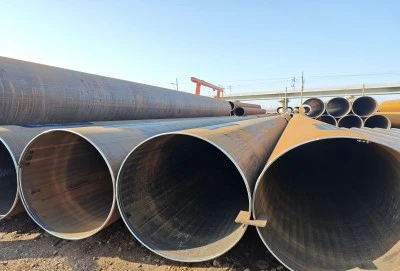In the realm of structural engineering and construction, the choice of materials plays a crucial role in determining the success and longevity of a project. Among the various options available, rolled and welded steel pipes have emerged as a preferred choice for many structural applications. This article delves into the reasons behind their popularity and explores their unique advantages in structural projects.
|
|
|
How Does the Strength-to-Weight Ratio of Rolled and Welded Pipes Benefit Structural Designs?
One of the primary reasons rolled and welded steel pipes are favored in structural projects is their exceptional strength-to-weight ratio. This characteristic allows engineers and architects to create robust structures without excessive weight, a factor that is particularly crucial in large-scale projects.
Rolled and welded steel pipes are manufactured through a process that enhances their structural integrity. The rolling process aligns the steel's grain structure, increasing its overall strength. Subsequently, the welding process creates a seamless join, further reinforcing the pipe's structural capabilities. This combination results in a product that can withstand significant loads while remaining relatively lightweight compared to solid steel members of similar strength.
The benefits of this high strength-to-weight ratio are manifold. Firstly, it allows for the construction of taller and more expansive structures without compromising on stability. Skyscrapers and long-span bridges, for instance, often rely on rolled and welded steel pipes in their core structural elements. Secondly, the reduced weight translates to lower transportation and installation costs, making these pipes a cost-effective choice for large projects.
Moreover, the strength-to-weight advantage of rolled and welded steel pipes contributes to improved seismic performance. In earthquake-prone regions, structures need to be both strong and flexible. The inherent properties of these pipes allow them to absorb and dissipate seismic energy effectively, enhancing the overall resilience of the structure.
It's worth noting that the strength-to-weight ratio can be further optimized by selecting the appropriate grade of steel and pipe dimensions. This flexibility allows engineers to tailor the structural elements to the specific requirements of each project, ensuring optimal performance and resource utilization.
Why are Large-Diameter Rolled and Welded Pipes Favored in Bridge and Building Construction?
Large-diameter rolled and welded steel pipes have found extensive application in bridge and building construction, owing to their unique properties and versatility. Their popularity in these sectors can be attributed to several key factors.
Firstly, large-diameter pipes offer excellent load-bearing capacity. In bridge construction, these pipes are often used as main support columns or as part of the bridge deck structure. Their ability to distribute loads evenly across their circular cross-section makes them ideal for supporting the immense weight of bridge decks and the dynamic loads of vehicular traffic.
In building construction, large-diameter rolled and welded pipes are frequently employed in the core structure of high-rise buildings. They serve as primary vertical support members, capable of transferring loads efficiently from upper floors to the foundation. The pipes' hollow nature allows for the integration of utility systems within the structural elements, maximizing usable floor space - a significant advantage in urban construction where space is at a premium.
Another advantage of large-diameter pipes in these applications is their aesthetic versatility. The smooth, continuous surface of these pipes can be left exposed as an architectural feature, contributing to modern, industrial-inspired designs. Alternatively, they can be easily concealed or integrated into various facade systems, offering architects flexibility in design.
The corrosion resistance of rolled and welded steel pipes is another factor favoring their use in bridges and buildings. When properly treated or coated, these pipes can withstand harsh environmental conditions, including exposure to moisture, salt spray, and atmospheric pollutants. This durability translates to lower maintenance costs and extended service life for the structures.
Furthermore, the use of large-diameter pipes can lead to more efficient construction processes. Their prefabricated nature allows for quicker on-site assembly, reducing construction time and labor costs. This efficiency is particularly valuable in bridge projects where minimizing traffic disruptions during construction is often a priority.
What Manufacturing Tolerances Make These Pipes Suitable for Critical Structural Loads?
The suitability of rolled and welded steel pipes for critical structural loads is largely attributed to the stringent manufacturing tolerances maintained during their production. These tolerances ensure consistency in the pipes' dimensions, material properties, and overall quality, which is crucial for their performance under demanding structural applications.
One of the key aspects of manufacturing tolerance is dimensional accuracy. Rolled and welded steel pipes are produced with precise control over their outer diameter, wall thickness, and length. For instance, high-quality pipes might have diameter tolerances as tight as ±0.5% and wall thickness tolerances of ±5%. This level of precision is essential for ensuring proper fit during assembly and maintaining the calculated load-bearing capacity of the structure.
Straightness is another critical tolerance in the manufacturing of these pipes. For structural applications, pipes are typically required to have a maximum deviation from straightness of 0.2% of the total length. This tolerance is crucial for maintaining the structural integrity of columns and other load-bearing elements, as even slight deviations can lead to eccentric loading and reduced load-carrying capacity.
The welding process itself is subject to strict quality control measures. Modern welding techniques, such as submerged arc welding used in LSAW (Longitudinal Submerged Arc Welded) pipes, produce high-integrity welds with minimal defects. The weld quality is often verified through non-destructive testing methods like ultrasonic testing or radiographic inspection, ensuring that the weld seam is as strong as the base material.
Material composition and mechanical properties are also tightly controlled. Steel used in these pipes must meet specific chemical composition requirements to ensure consistent strength, ductility, and weldability. Mechanical properties such as yield strength, tensile strength, and elongation are tested to verify compliance with relevant standards such as API 5L or ASTM A53.
Surface finish and roundness are additional parameters that are closely monitored. A smooth surface finish reduces stress concentrations and improves corrosion resistance, while maintaining roundness within specified tolerances is crucial for even load distribution and proper connection with other structural elements.
These stringent manufacturing tolerances collectively ensure that rolled and welded steel pipes can reliably handle critical structural loads. They provide engineers with the confidence to push the boundaries of structural design, knowing that the materials will perform as expected under various loading conditions.
Longma Group specializes in producing rolled and welded steel pipes that adhere to various international standards including API 5L, ASTM A53, ASTM A500, ASTM A252, and ASTM A795. Their product range covers outer diameters from 1/2" to 72" and thicknesses from SCH10 to SCH160. With a substantial stock quantity of 50-150 tons, they are capable of meeting both small and large-scale project requirements. For more information or to discuss your specific needs, please don't hesitate to reach out to them at info@longma-group.com. Their team is dedicated to providing excellent products and services tailored to your structural project requirements.














